Now that PC hardware exploration is part of my job, I sometimes forget where my PC journey began. As kids, my brother and I built PCs in the garage just for fun. I’m not going to say there was anything special about a computer we built out of used parts we picked up from the classifieds section of the newspaper, but we enjoyed every step of the process. (Yes, that last sentence made me dated.)
Every once in a while, something new comes along in the PC hardware world that rekindles that sense of excitement within me. Right now, the latest AMD Ryzen 9000 series processors and accompanying X870E/X870 motherboards are taking me back to my garage PC building days and getting me excited to start from scratch with a new build. Here’s everything I’m excited to experience with this new hardware.
DDR5 continues to evolve
I might have to give my geek badge back for saying this, but optimizing memory settings was my least favorite part of building a new PC. Like many geeks out there, I welcomed the arrival of memory profiles like EXPO, and have taken the easy route ever since when it comes to memory settings.
But the new memory features of the X870E/X870 platform might get me tinkering again. It’s nice to have JEDEC support for DDR5-5600 out of the box, which means your memory kit will run fast even if you’re using baseline settings. Support for on-the-fly memory overclocking is also a nice perk. Being able to adjust memory speeds and timings in real time using the Ryzen Master application makes optimizing your settings that much easier. Plus, with the new Memory Optimized Performance Profile (MOPP), you can automatically switch between JEDEC and EXPO profiles depending on the type of application you’re running.
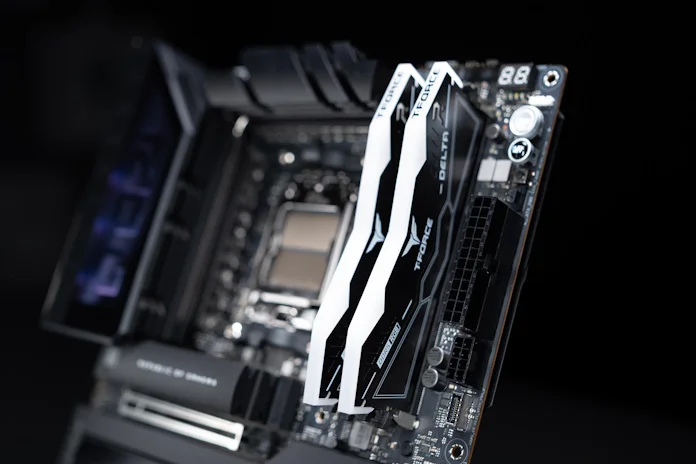
AMD isn’t the only one announcing new memory features. We’re also excited about NitroPath DRAM technology, featured exclusively on the ROG Crosshair X870E Hero and ROG Strix X870E-E Gaming WiFi motherboards. This innovative DRAM slot design reduces noise interference with shorter gold finger pins and optimized signal paths within the motherboard. This means you’re better prepared to push the overclocking limits of your DDR5 RAM while enjoying enhanced system stability.
With improved baseline speeds, support for real-time memory overclocking, and new DRAM slot designs, ASUS and AMD have achieved something that was once thought impossible: tinkering with memory settings is now interesting again.
A Robust Platform for Custom AI PCs
Like many PC enthusiasts, I’ve been eagerly exploring opportunities to take advantage of new apps and features that are powered by AI. As a gamer, I’ve already seen firsthand how technologies like Ray Reconstruction and DLSS can make games look incredibly realistic and run at incredibly smooth frame rates. As an amateur photographer, I use AI-powered tools in Photoshop almost every time I edit a photo, and I’m excited to see how AI can also dramatically improve productivity, video editing, and music recording.
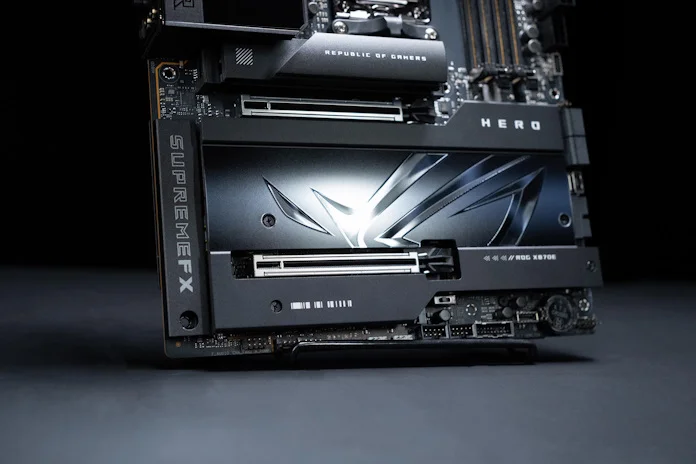
To get the most out of AI, you need an AI PC. ASUS X870E motherboards and the new AMD Ryzen 9000 series CPUs were designed specifically for the era of AI PCs. The high-end ROG Crosshair X870E Hero and ProArt X870E-Creator WiFi motherboards feature dual PCIe 5.0 x16 slots, so you can leverage not one but two graphics cards to accelerate your AI workloads. These boards offer the high-end cooling options you need to keep your components happy during sustained workloads, and smart one-click technologies like AI Overclocking, AI Cooling II, and AI Networking II streamline the entire experience.
Time to upgrade your wireless network?
The arrival of WiFi 7 is sure to be one of the most important events in the technology world in 2024. Like most of us, my home is filled with connected devices competing for bandwidth. My wife and I both work primarily from home, so we can’t let the whims of an older generation router determine the winners and losers of our wireless network.
Upgrading your whole home to WiFi 7 will solve a lot of problems. The generational speed boost that WiFi 7 provides speaks for itself, but that’s not all. WiFi 6E introduced the 6GHz band, but WiFi 7 gives you even more thanks to ultra-wide 320MHz channels and MLO. The new ASUS WiFi 7 router also makes it easy to use network segmentation options. You want to connect all of your kids’ devices to their own network so that you can automatically cut off internet access when they go to bed.
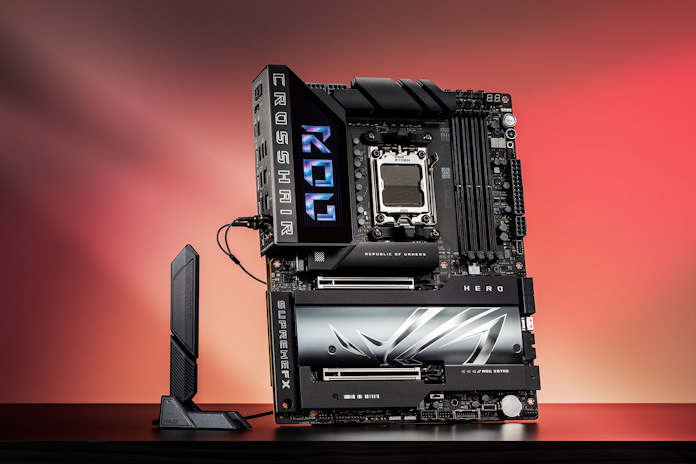
To get the most out of your new WiFi 7 routers, you’ll also need WiFi 7 devices, which is where the new lineup of X870E and X870 motherboards comes in. With the sole exception of the ASUS Prime X870-P, which is a motherboard without an onboard WiFi module, all ASUS X870E and X870 motherboards support WiFi 7. Whether you buy the top-of-the-line ROG Crosshair X870E Hero or the more mainstream TUF Gaming X870-Plus WiFi, you’ll have access to the next generation of wireless networking.
BIOS, updated
Of all the changes I’ve seen in my years of building PCs, there’s one element of the process that has remained pretty much the same: the BIOS. While many new features have been added over the years, its design, interface, and basic functionality remain pretty much the same as when I first started building PCs. And that’s okay; I love my BIOS because it’s reliable, functional, and proven.
But diehard that I am, stuck in the past, I am intrigued by the ASUS BIOS updates for the X870E and X870 motherboards. First off, it bumps up the BIOS resolution to 1920×1080. This change lets you see more content at a glance and makes it easier to explore the available settings and find the one you want.
Secondly, the new BIOS Q-Dashboard helps bridge the gap between the BIOS settings and the physical layout of your new motherboard. It displays a perspective view of your exact motherboard model right in the BIOS, with all the important components and connections neatly labeled.
It’s easy to imagine that the new BIOS Q-Dashboard will play a key role in getting you used to your new motherboard. The increased resolution will definitely streamline your operations whenever you need to adjust settings. When it comes to the BIOS, I’m not interested in changes for the sake of changes, but once you start using these updates, you’ll wonder how you ever got this far.
Easy PC DIY experience
As a veteran of the PC building world, it’s clear to me how much easier it is now. With each new generation of parts, the PC building process becomes smoother and more streamlined, and there are far more resources available for beginner builders today than when I first started.
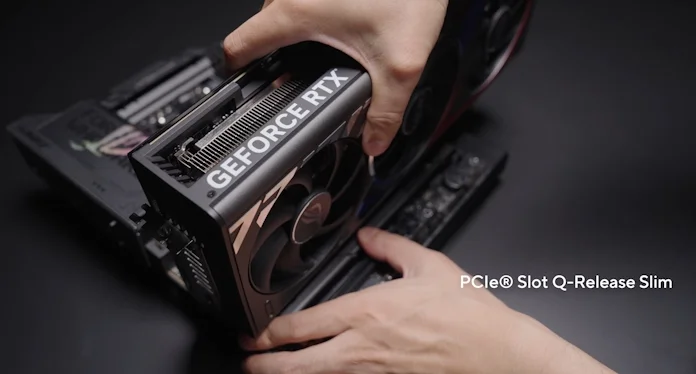
Among the new PC DIY-friendly updates coming to the X870E and X870 motherboards, the one I’m particularly intrigued by is the PCIe Slot Q-release Slim. By default, PCIe x16 slots have a small plastic latch that releases any add-in card you install. But if you install a graphics card with a sturdy backplate and a thick, powerful cooler, that latch can be hard to reach.
Our PCIe Slot Q-Release Slim neatly solves this problem. The mechanism means there’s no need to release latches or press buttons. To remove the graphics card, first press the motherboard with one hand to keep the graphics card from moving as you remove it. Grasp the left side of the graphics card (near the I/O bracket). Then pull upwards while tilting the card slightly, and the graphics card will release from the PCIe slot. It’s that easy!
Sophisticated beauty, top performance
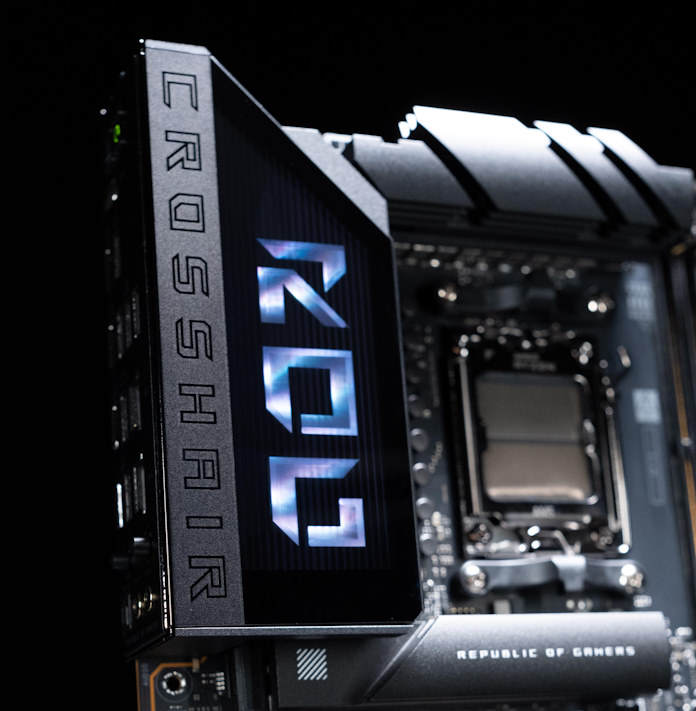
My first custom-built PCs were all beige boxes (thanks to the 1990s design aesthetic). As PC chassis design became more popular in the 2000s, my imagination expanded too. I’ve built massive full tower PCs, compact space-saving machines, gaming rigs with stunning synchronized RGB LED lighting effects, eye-catching all-white PCs, and more.
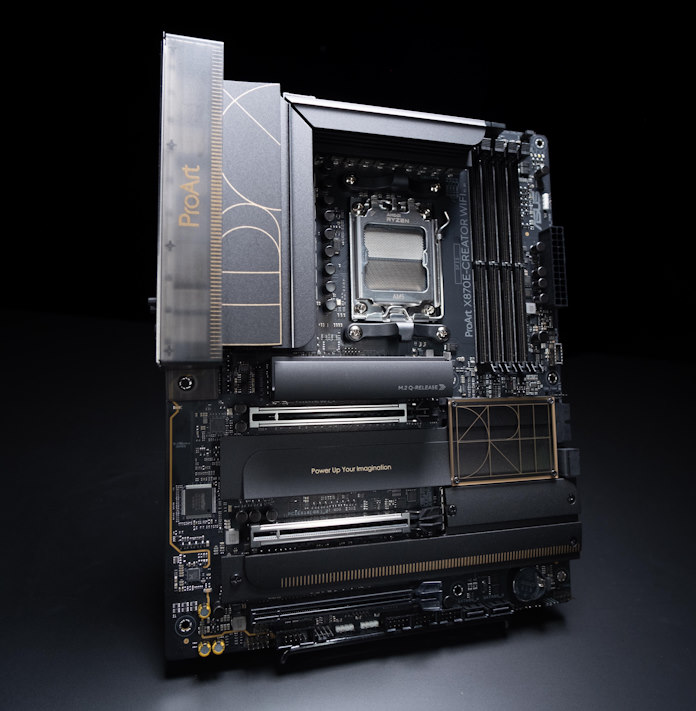
Lately, my tastes have been leaning towards minimalist design, where form matches function. That’s why I love the ProArt PC component ecosystem. They’re built to meet the performance demands of professional creators, and are wrapped in a professional aesthetic that won’t look out of place. With its black and gold color scheme, parallel lines, and understated trim, the ProArt X870E-Creator WiFi looks great in the ProArt PA602 chassis. The board’s two onboard USB4 ports, dual ethernet ports, solid cooling, and WiFi 7 support were already appealing, but it was the premium design that sold me on this board.
Check out the full lineup of ASUS X870E / X870 motherboards
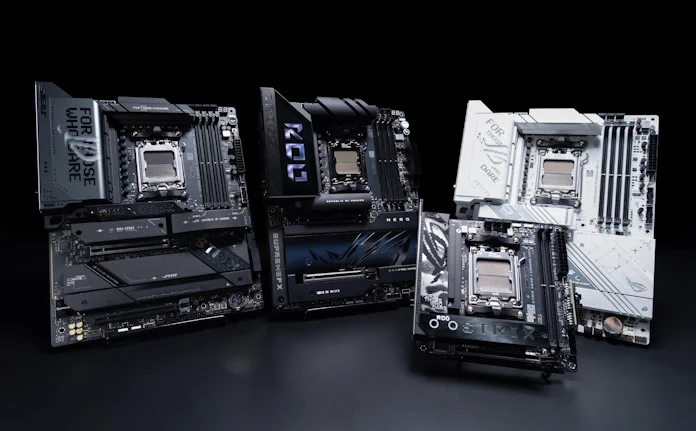
All the new features announced for the AMD Ryzen 9000 Series CPUs and the ASUS X870E / X870 motherboard lineup have me excited to roll up my sleeves and get building. If you’re as intrigued as I am about the performance potential and capabilities of these new components, be sure to head over to our complete X870E / X870 motherboard guide to discover all the new options.


